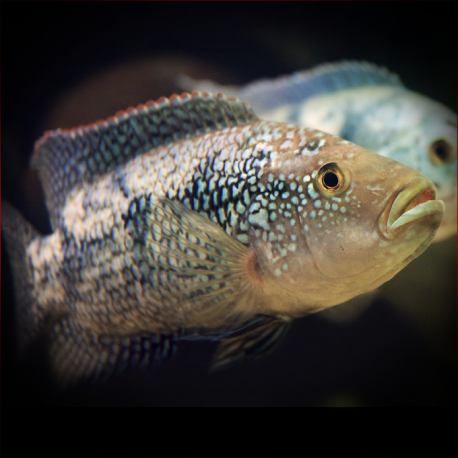More info
Datasheet
| Minimum Tank Size | 225 litres / 59.44 US gallons |
| Maximum Size | 25.4cm / 10.00inches |
| Temperament | Aggressive |
| Care Description | Easy |
| Temperature | 25.6°C / 78.08°F - 27.8°C / 82.04°F |
| Carbonate Hardness | 5-12 |
| pH | 6.5-8.0 |
General Description
The Jack Dempsey, scientifically known as Rocio octofasciatum, is a captivating freshwater fish originating from Central America. It boasts a dark brown to gray base coloration, adorned with iridescent blue and green spots that intensify during breeding. This species showcases a distinguishing red-lined dorsal fin, with males flaunting vibrant colors compared to the more subdued females.
Aquarium Setup
To house a Jack Dempsey, a minimum 55-gallon tank is recommended, with a fine sand substrate and ample rocks and roots for hiding spots. Hardy plants are advised, as these fish tend to burrow and may attack softer vegetation. Creating territories within the aquarium using sturdy plants can help manage their territorial nature and tendency to prey on smaller tankmates.
Behaviour
Known for their aggressive temperament, Jack Dempseys are territorial and may target smaller fish that fit into their mouths. They prefer neutral water with a pH around 7.0, moderate hardness (5-12 kh), and temperatures between 78-82°F (25.6-27.8°C). These fish thrive in well-oxygenated environments and exhibit open breeding behavior, spawning in burrows and safeguarding their offspring diligently.
Feeding and Diet
Carnivorous by nature, Jack Dempseys have versatile diets that include prepared, frozen, and live foods. They eagerly consume freeze-dried bloodworms, tubifex, ocean plankton, and live fish, making it crucial to provide a varied diet to ensure their nutritional needs are met.
Reproduction & Dimorphism
Breeding Jack Dempseys lay up to 500 eggs in burrows, showcasing robust parental care as they protect their fry. Distinguishing between male and female specimens can be challenging, as females are typically smaller and less brightly colored than their male counterparts. Once the fry mature, these fish often continue breeding cycles.
Habitat and Distribution
In their natural habitat, Jack Dempseys inhabit warm, murky waters of Central America. They are commonly found in rivers, streams, and canals, thriving in regions where they can seek shelter among rocks and submerged vegetation. This species' distribution spans various water bodies in Central America, where they showcase their territorial behavior and unique colorations.

